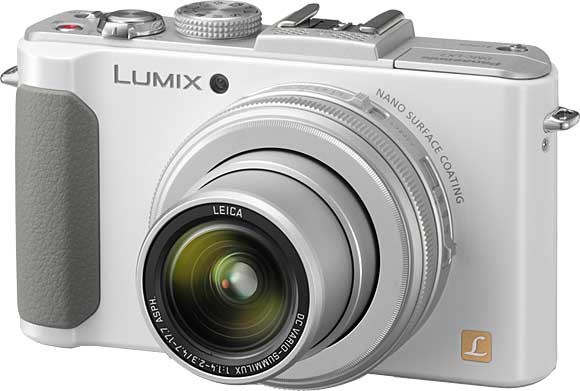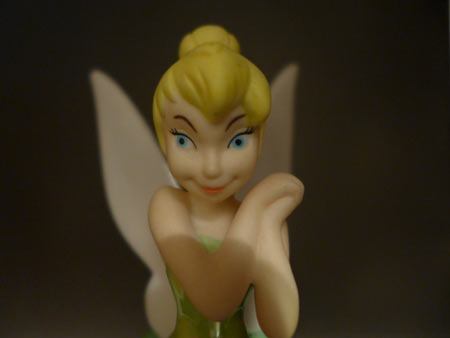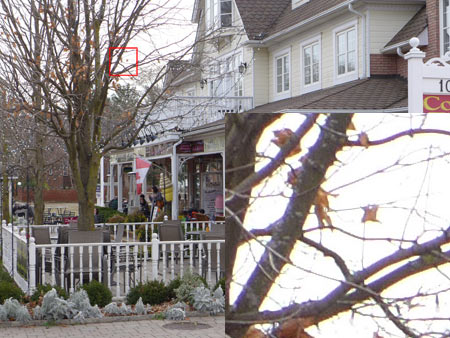Review Date: November 23, 2012
Category: Serious Amateur

Photoxels Gold Award – Premium Compact Camera
IMAGE QUALITY
The Panasonic Lumix DMC-LX7 is a compact camera targeted to serious amateur photographers. It has 10.1 megapixel resolution on a 1/1.7-in. MOS image sensor.
The Panasonic LX7 has very good image quality (including very good low-light performance) up to ISO 400 with plenty of details preserved and good colors, with very usable ISO 800 and usable ISO 1600. Higher ISOs suffer from noise and detail loss.
| Lumix 24-90mm 3.8x Optical Zoom |
|
 |
 |
| Wide-angle 4.7mm (24mm, 35mm equivalent) |
Telephoto 17.7mm (90mm, 35mm equivalent) |
In the above pictures, we show the coverage for 24mm and 90mm (35mm equivalent).
The Panasonic LX7 has full exposure flexibility with PASM modes and Program Shift. Auto Bracketing of up to 3 pictures (+/- 1/3 EV to +/- 3EV) is possible. A Histogram can be displayed in both Live and Playback modes.
The LX7’s lens allows you to focus as close as 1cm (0.4 in.) at wide-angle macro and 30cm (12 in.) at Tele macro. You have to slide the Focus Selector Switch on the lens barrel to AF Macro for that. AF locks precisely and fast. As the above picture shows, lighting your subject that close can be problematic, and the shadow of the camera has fallen on the lower part of the subject.
The AF Area covers 31 x 23 areas at the smallest AF frame. The AF frame size can be reduced or increased by rotating the Rear dial.
There are three metering modes: Multiple (Multi-Pattern), Center Weighted and Spot.
| Auto White Balance Indoors | |
 |
 |
| AWB | Custom WB |
As the above two pictures show, the Auto White Balance (AWB) is not quite accurate indoors under artificial lighting [I have two energy-saving fluorescent light bulbs on the ceiling]. Fortunately, there is Manual WB and WB ADJUST that are easy to set and provide very good results. In bright natural light, AWB works very well.
| ISO Comparisons | |
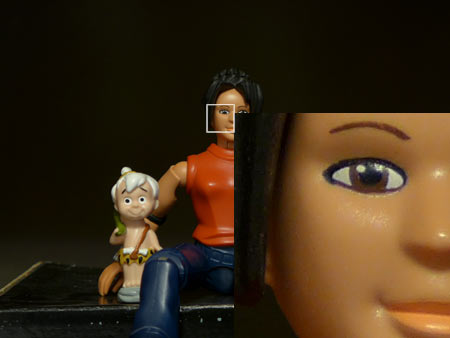 |
|
| ISO 80 | |
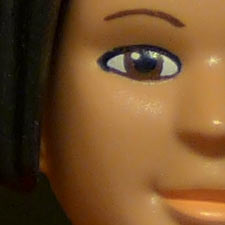 |
 |
| ISO 100 | ISO 200 |
 |
 |
| ISO 400 | ISO 800 |
 |
 |
| ISO 1600 | ISO 3200 |
 |
|
| ISO 6400 | |
The Panasonic LX7 has 8 ISO settings going from ISO 80 to ISO 6400, plus an extended ISO 12,800. The 100% crops above (area delimited by the white square) demonstrate the noise at the available ISO Speeds. At ISO 80 to 400, noise is under control. Noise starts to be visible at ISO 800 but is still very acceptable, with ISO 1600 also quite usable in smaller prints or for Web display. Noise (with loss of detail) is apparent at higher ISOs. Overall, very good noise handling.
If you need finer ISO adjustments (e.g. ISO 80, 100, 125, 160, 200, etc.), you can set the ISO increments to 1/3EV. In ISO AUTO mode, you can also set the max. ISO the camera will use [MENU – REC – ISO LIMIT SET – select an ISO value from 200 to 3200].
CA is under control in everyday shots and is minimal even in very high contrast shots. The corner delimited by the red square at top left, and reproduced at 100% crop at bottom right, shows minimal purple fringing.

Long Exposure - 17.7mm, Manual, Spot, 250 sec., F2.3, ISO 80, Custom WB, Self-timer (10 sec.), Tripod Used
Our Long Shutter Speed test is a torture test for digital cameras. Here we test whether (and how well) a camera can lock focus, provide accurate WB and obtain a correct exposure in extreme low light situations. I resize the AF frame so the camera quickly and precisely focuses on Bamm-Bamm’s eyes. The Panasonic LX7 passes this test very well, locking AF on the very first try in almost total darkness (but with the aid of the AF Assist Lamp).
The Panasonic LX7 allows the use of a long shutter speed of up to 250 sec. in M mode, therefore allowing very nice night photography. Generally, with image sensors, noise usually becomes more prominent at slow shutter speeds. Noise Reduction kicks in and you’ll notice a longer processing time (approx. twice as long) before the next picture can be taken.
To test this noise reduction algorithm, we take a low-light indoors shot. I experiment a bit to obtain the optimum exposure, eventually settling on 250 sec. at F2.3. Even at this very long exposure, the noise reduction seems to be working great, producing a nice smooth blurring effect of the background.
We find the overall image quality of the Panasonic Lumix DMC-LX7 at ISO 80 to be excellent with good details in the shadows and highlights. Images up to ISO 400 are very good quality with low noise. ISO 800 to 1600 are usable. Overall, very good image quality.
View the Panasonic LX7 Photo Gallery [In the Photo Gallery, click on the picture of the camera to return here.]
Next: Panasonic LX7 Handling & Feel


